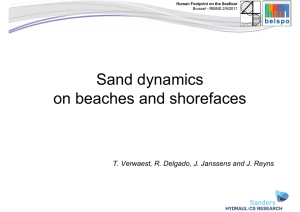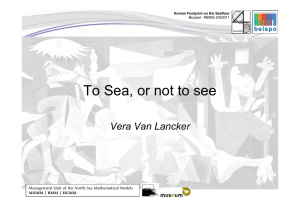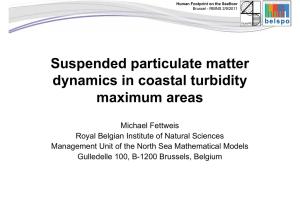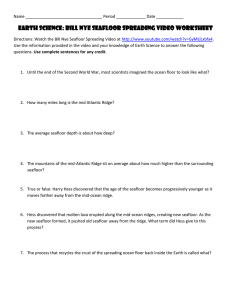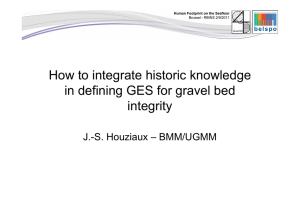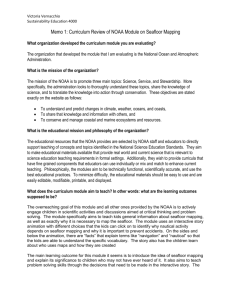Changes in macrobenthos: past versus present Jean-Sébastien Houziaux BMM - UGMM
advertisement
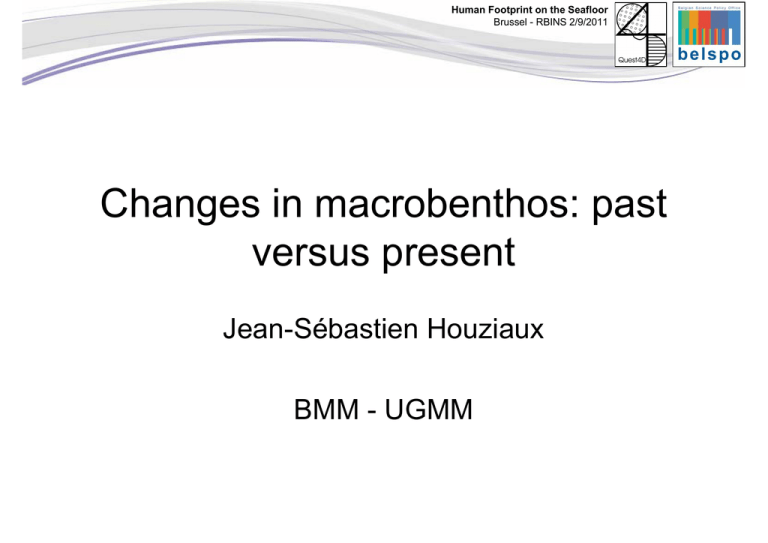
Human Footprint on the Seafloor Brussel - RBINS 2/9/2011 Changes in macrobenthos: past versus present Jean-Sébastien Houziaux BMM - UGMM Human Footprint on the Seafloor Brussel - RBINS 2/9/2011 New European legislation: what is a “Good Ecosystem State”? GES • Since the 1990s, various european Directives aimed at nature protection have been issued. The most recent is the « Marine Strategy » Framework Directive – « MSFD » • The MSFD targets reaching a GES in European seas. Targets are defined for 11 different descriptors of the marine ecosystem, including « seafloor integrity ». – “Sea-floor integrity is at a level that ensures that the structure and functions of the ecosystems are safeguarded and benthic ecosystems, in particular, are not adversely affected.” • This directive and others involves the definition of objective criteria towards measurement of the GES • The measurement of the amplitude of change induced by human pressures is necessary to set meaningful targets => Baseline assessment => Benthos composition = sensitive indicator for change in the seafloor condition => Monitoring Human Footprint on the Seafloor Brussel - RBINS 2/9/2011 Belgium: a unique historical macrobenthic data set: The surveys and material of G. Gilson, 1899-1908 Gilson’s « ground-collector » Gilson’s dredge (Tow : one nautical mile) Human Footprint on the Seafloor Brussel - RBINS 2/9/2011 Seafloor and benthos, 1900: highlights Western coast: moderate diversity and density (in- and epifauna) Epibenthic community of open-sea gravels: large taxonomic diversity and densities Highest densities (infauna), low species diversity Human Footprint on the Seafloor Brussel - RBINS 2/9/2011 Coastal waters: case of dominant bivalves • Long-term analysis challenges for coastal macrobenthos: Gilson’s dredge data Ù Recent Van Veen data, 1994-2008 (joint DB of U. Gent + ILVOFisheries) 2°30 ⇒ Sampling gear incompatibility: Point sampling Ù towed dredge (1,9 km long) Different efficiencies 51°30 ⇒ Different spatial distributions ⇒ Historic data on soft-bottom macrobenthos: polychaetes not robust yet Solutions: – Spatial analysis of numerically dominant bivalves through data gridding 51°10 – Standardize abundances to maximum values => distribution of relative densities – P/A data => difference maps 3°30 Walchere n NL Westerschelde estuary 51°20 • 3° F Human Footprint on the Seafloor Brussel - RBINS 2/9/2011 Coastal waters: case of dominant bivalves General figures 45 1899-1914 1994-2008 Station occupancy rate (%) 40 Station occupancy rates 35 30 25 20 15 10 5 M ys el la bi de nt at a A br a M al ac ba om a ba lth ic Te a lli na t e Te nu lli is Ve na ne py ru g pi m s ae se a ne ga le ns Te is lli na fa bu la Te lli En m ya si s fe rr ug in os a un ca ta vi tta tu s su bt r Sp is u la el lip tic a D on ax a so lid a Sp is ul 100% 90% Contribution to total abundance Proportion of total abundance Sp is ul a M ac tr a st ul to r um 0 80% Tellimya ferruginosa Ensis directus Tellina tenuis 70% Tellina pygmaea Tellina fabula 60% Venerupis senegalensis Mactra stultorum 50% Macoma balthica Spisula elliptica Spisula solida 40% Mysella bidentata Donax vittatus 30% Spisula subtruncata Abra alba 20% 10% 0% 1899-1914 1994-2008 Human Footprint on the Seafloor Brussel - RBINS 2/9/2011 Coastal waters: case of dominant bivalves Geographic spreading Muddy fine sand ⇒ Probable impact of change in fine sediment dynamics (increased turbidity?) ⇒ Probable effect of eutrophication / pollution: increased benthic biomass/productivity? species: Expansion BUT: (+ shifts in relative density distribution) - Hydro-climatic factors (unlikely) - Ensis directus invasion (unlikely) Other factors (fishery effects)?… Shallow clean fine sand, filter- feeding species: Change 1900 – 1970 > Change 1970-2000s Regression => More ‘sophisticated’ biodiversity analyses once polychaete data checked Macoma balthica (estuarine): => Incorporation of recent data from Expansion from Schelde Dutch waters mouth to the entire coastal waters Human Footprint on the Seafloor Brussel - RBINS 2/9/2011 Westerschelde mouth : 1900 versus 1980-82 (J. Craeymeersch, IMARES) 100% Venerupis Phaxas Nucula nitidosa Mya arenaria Ensis siliqua var_ minor Ensis Chamelea gallina Cerastoderma edule Angulus tenuis Tellina tenuis Fabulina fabula Aequipecten opercularis Tellimya ferruginosa Striarca lactea Barnea candida Modiolus modiolus Spisula elliptica Spisula solida Petricola pholadiformis Mactra stultorum Mytilus edulis Donax vittatus Macoma balthica Abra alba Mysella bidentata Spisula subtruncata 90% 80% 70% 60% 50% 40% 30% 20% 10% 0% 1900_RA% 1980_RA% Station occupancy (% stations - spreading) 45.00 40.00 35.00 30.00 25.00 20.00 15.00 10.00 5.00 0.00 Sp isu la My sub t se lla runca bi d t en a tat Ma Ab a co r ma a alb a b Do na althic xv a My itta tilu tus M Pe tric actra s ed ola stu ulis l ph ola torum dif Sp o rm isu is la Sp Mo isula solid a di o el l ipt lus ica m Ba rne odio lus ac Str an Te llim iarca dida Ae ya qu lac fer ipe rug tea cte ino no sa pe Fa rcu bu l ar lin i s af ab Te ula llin at An en Ce gu uis ras lus t od ten erm ui s Ch ae am du el e le ag En all sis i n sili a qu En av sis ar _ mi My no aa r Nu ren cu a ria la ni t ido sa Ph ax a Ve s ne rup is Contribution to total density (14 species) 1900_F% 1980_F% Human Footprint on the Seafloor Brussel - RBINS 2/9/2011 Present-day observation • Ecosystem engineering – Rabaut and coll. – Lanice conchilega (tube building segmented worm) • Essential structuring component of the “Abra alba” macrobenthic community – Owenia fusiformis (tube building segmented worm) • Sand bank stabilisation. Recently thriving • And in the 1900s and 1970s? => Gilson data and literature Human Footprint on the Seafloor Brussel - RBINS 2/9/2011 Coastal ‘ecosystem engineers’ in the past L. conchilega • 1900: occasional - widespread • 1970: occasional • 1980s: common, max densities 2000/m² • 1990s-2000s: essential component of A. alba community – very large densities (max 10,000/m² => “reefs”) • O. fusiformis • 1900: occasional, offshore • 1970: occasional, offshore • 1980s: occasional, low densities • Mid-2000s: strong expansion in muddy fine sands with locally very large densities (max 11,000/m² => “reefs”) (NB. Typical component of sandy gravel associated fauna too) => Recent thriving Human Footprint on the Seafloor Brussel - RBINS 2/9/2011 Conclusions • Macrobenthic communities of coastal waters since the 1970s are altered compared to the early 1900s, with different species thriving from the local pool. • Increased influence of background turbidity (i.e. increased chronic deposition of mud)? • Relatively more species contribute substantially to bivalve biomass: suggestion of biomass increase? • Findings are consistent with moderate levels of organic enrichment in highly mixed coastal waters (eutrophisation effect) • “Ecosystem engineer” tube-building worms: fate in the long run, link with ecosystem disturbance? Human Footprint on the Seafloor Brussel - RBINS 2/9/2011 Thank you for your attention !
